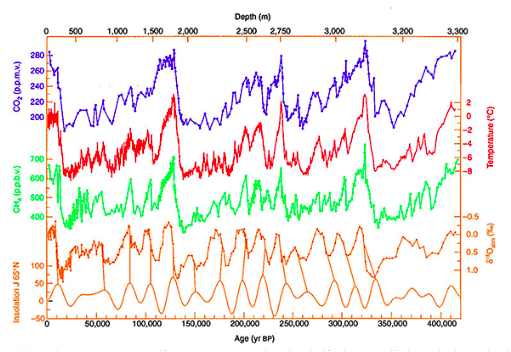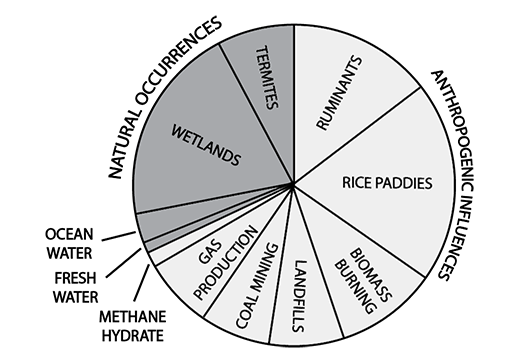10.2: Changes in Atmospheric Composition
- Page ID
- 31569
\( \newcommand{\vecs}[1]{\overset { \scriptstyle \rightharpoonup} {\mathbf{#1}} } \)
\( \newcommand{\vecd}[1]{\overset{-\!-\!\rightharpoonup}{\vphantom{a}\smash {#1}}} \)
\( \newcommand{\id}{\mathrm{id}}\) \( \newcommand{\Span}{\mathrm{span}}\)
( \newcommand{\kernel}{\mathrm{null}\,}\) \( \newcommand{\range}{\mathrm{range}\,}\)
\( \newcommand{\RealPart}{\mathrm{Re}}\) \( \newcommand{\ImaginaryPart}{\mathrm{Im}}\)
\( \newcommand{\Argument}{\mathrm{Arg}}\) \( \newcommand{\norm}[1]{\| #1 \|}\)
\( \newcommand{\inner}[2]{\langle #1, #2 \rangle}\)
\( \newcommand{\Span}{\mathrm{span}}\)
\( \newcommand{\id}{\mathrm{id}}\)
\( \newcommand{\Span}{\mathrm{span}}\)
\( \newcommand{\kernel}{\mathrm{null}\,}\)
\( \newcommand{\range}{\mathrm{range}\,}\)
\( \newcommand{\RealPart}{\mathrm{Re}}\)
\( \newcommand{\ImaginaryPart}{\mathrm{Im}}\)
\( \newcommand{\Argument}{\mathrm{Arg}}\)
\( \newcommand{\norm}[1]{\| #1 \|}\)
\( \newcommand{\inner}[2]{\langle #1, #2 \rangle}\)
\( \newcommand{\Span}{\mathrm{span}}\) \( \newcommand{\AA}{\unicode[.8,0]{x212B}}\)
\( \newcommand{\vectorA}[1]{\vec{#1}} % arrow\)
\( \newcommand{\vectorAt}[1]{\vec{\text{#1}}} % arrow\)
\( \newcommand{\vectorB}[1]{\overset { \scriptstyle \rightharpoonup} {\mathbf{#1}} } \)
\( \newcommand{\vectorC}[1]{\textbf{#1}} \)
\( \newcommand{\vectorD}[1]{\overrightarrow{#1}} \)
\( \newcommand{\vectorDt}[1]{\overrightarrow{\text{#1}}} \)
\( \newcommand{\vectE}[1]{\overset{-\!-\!\rightharpoonup}{\vphantom{a}\smash{\mathbf {#1}}}} \)
\( \newcommand{\vecs}[1]{\overset { \scriptstyle \rightharpoonup} {\mathbf{#1}} } \)
\( \newcommand{\vecd}[1]{\overset{-\!-\!\rightharpoonup}{\vphantom{a}\smash {#1}}} \)
\(\newcommand{\avec}{\mathbf a}\) \(\newcommand{\bvec}{\mathbf b}\) \(\newcommand{\cvec}{\mathbf c}\) \(\newcommand{\dvec}{\mathbf d}\) \(\newcommand{\dtil}{\widetilde{\mathbf d}}\) \(\newcommand{\evec}{\mathbf e}\) \(\newcommand{\fvec}{\mathbf f}\) \(\newcommand{\nvec}{\mathbf n}\) \(\newcommand{\pvec}{\mathbf p}\) \(\newcommand{\qvec}{\mathbf q}\) \(\newcommand{\svec}{\mathbf s}\) \(\newcommand{\tvec}{\mathbf t}\) \(\newcommand{\uvec}{\mathbf u}\) \(\newcommand{\vvec}{\mathbf v}\) \(\newcommand{\wvec}{\mathbf w}\) \(\newcommand{\xvec}{\mathbf x}\) \(\newcommand{\yvec}{\mathbf y}\) \(\newcommand{\zvec}{\mathbf z}\) \(\newcommand{\rvec}{\mathbf r}\) \(\newcommand{\mvec}{\mathbf m}\) \(\newcommand{\zerovec}{\mathbf 0}\) \(\newcommand{\onevec}{\mathbf 1}\) \(\newcommand{\real}{\mathbb R}\) \(\newcommand{\twovec}[2]{\left[\begin{array}{r}#1 \\ #2 \end{array}\right]}\) \(\newcommand{\ctwovec}[2]{\left[\begin{array}{c}#1 \\ #2 \end{array}\right]}\) \(\newcommand{\threevec}[3]{\left[\begin{array}{r}#1 \\ #2 \\ #3 \end{array}\right]}\) \(\newcommand{\cthreevec}[3]{\left[\begin{array}{c}#1 \\ #2 \\ #3 \end{array}\right]}\) \(\newcommand{\fourvec}[4]{\left[\begin{array}{r}#1 \\ #2 \\ #3 \\ #4 \end{array}\right]}\) \(\newcommand{\cfourvec}[4]{\left[\begin{array}{c}#1 \\ #2 \\ #3 \\ #4 \end{array}\right]}\) \(\newcommand{\fivevec}[5]{\left[\begin{array}{r}#1 \\ #2 \\ #3 \\ #4 \\ #5 \\ \end{array}\right]}\) \(\newcommand{\cfivevec}[5]{\left[\begin{array}{c}#1 \\ #2 \\ #3 \\ #4 \\ #5 \\ \end{array}\right]}\) \(\newcommand{\mattwo}[4]{\left[\begin{array}{rr}#1 \amp #2 \\ #3 \amp #4 \\ \end{array}\right]}\) \(\newcommand{\laspan}[1]{\text{Span}\{#1\}}\) \(\newcommand{\bcal}{\cal B}\) \(\newcommand{\ccal}{\cal C}\) \(\newcommand{\scal}{\cal S}\) \(\newcommand{\wcal}{\cal W}\) \(\newcommand{\ecal}{\cal E}\) \(\newcommand{\coords}[2]{\left\{#1\right\}_{#2}}\) \(\newcommand{\gray}[1]{\color{gray}{#1}}\) \(\newcommand{\lgray}[1]{\color{lightgray}{#1}}\) \(\newcommand{\rank}{\operatorname{rank}}\) \(\newcommand{\row}{\text{Row}}\) \(\newcommand{\col}{\text{Col}}\) \(\renewcommand{\row}{\text{Row}}\) \(\newcommand{\nul}{\text{Nul}}\) \(\newcommand{\var}{\text{Var}}\) \(\newcommand{\corr}{\text{corr}}\) \(\newcommand{\len}[1]{\left|#1\right|}\) \(\newcommand{\bbar}{\overline{\bvec}}\) \(\newcommand{\bhat}{\widehat{\bvec}}\) \(\newcommand{\bperp}{\bvec^\perp}\) \(\newcommand{\xhat}{\widehat{\xvec}}\) \(\newcommand{\vhat}{\widehat{\vvec}}\) \(\newcommand{\uhat}{\widehat{\uvec}}\) \(\newcommand{\what}{\widehat{\wvec}}\) \(\newcommand{\Sighat}{\widehat{\Sigma}}\) \(\newcommand{\lt}{<}\) \(\newcommand{\gt}{>}\) \(\newcommand{\amp}{&}\) \(\definecolor{fillinmathshade}{gray}{0.9}\)Since the rise of oxygen, 2 billion years ago, the nitrogen and oxygen fractions in the atmosphere have been stable. Water vapor is highly variable but, on average, appears to also have been fairly stable. Recent data from satellites and sondes indicate that perceptible water (the total amount of water that is in a column from the surface to space) has increased 1.3 ± 0.3% per decade over the oceans in the past 25 years (Trenberth et al., Climate Dynamics, 2005).
Historical (up to 500 years before the present) changes in CO2 and CH4 show large, rapid variations. Note that the historical range for CO2 is 200-300 parts per million (10-6), and for methane is 350-400 parts per billion (ppbv). These changes in gas amounts have been driven by changes in Earth's temperature, which come from changes in Earth's orbit, the axis of Earth's rotation, and volcanoes. Until recently, changes in Earth's temperature caused changes in these gas amounts, which then reinforced the warming. In the past century, changes in the gas amounts have been driving the observed change in Earth's temperature.
 Changes in carbon dioxide, methane, and temperature over the past half million years. As measured from gases trapped in an ice core at Vostok, Antarctica. Credit: "Vostok 420ky curves insolation". Licensed under Public Domain via Wikimedia Commons
Changes in carbon dioxide, methane, and temperature over the past half million years. As measured from gases trapped in an ice core at Vostok, Antarctica. Credit: "Vostok 420ky curves insolation". Licensed under Public Domain via Wikimedia Commons
The recent changes in carbon dioxide show a fairly constant increase over the past 50 years. There is a smaller seasonal cycle imposed on this trend. This seasonal behavior occurs because CO2 is taken up by plants in the northern hemisphere in summer, since most of the plants are in the northern hemisphere. Note that the current increase to above 400 ppm now extends well above any other time in the past half million years. Much of this CO2increase can be linked to fossil fuel combustion. We will examine the scientific consequences of these CO2 levels in the lesson on applications of radiation.
 Atmospheric CO2 mixing ratios measured at Mauna Loa, Hawaii for more than 50 years. Credit: NOAA
Atmospheric CO2 mixing ratios measured at Mauna Loa, Hawaii for more than 50 years. Credit: NOAA
Another important trace gas is methane (CH4), which is often called natural gas when it is used to produce power and heat. Methane has many sources, some of them natural and some of them anthropogenic (meaning human-made). Its atmospheric mixing ratio is now greater than 1800 parts per billion (ppb, or a fraction of 10-9 of air). We see from the figures below that almost 2/3 of atmospheric methane sources are anthropogenic and that methane measured at Hawaii, like all other locations, has been increasing except for the early to mid 2000s. This slowdown is not understood, but since the late 2000s, methane has been increasing again.
 Sources of atmospheric methane: Freshwater, ocean water, wetlands, termites, ruminants, rice paddies, biomass burning, landfills, coal mining, gas production, methane hydrate. Ruminants are cattle, sheep, goats, etc. 2/3 of the total is due to human activities.
Sources of atmospheric methane: Freshwater, ocean water, wetlands, termites, ruminants, rice paddies, biomass burning, landfills, coal mining, gas production, methane hydrate. Ruminants are cattle, sheep, goats, etc. 2/3 of the total is due to human activities.
 Changes in methane. Left, since 800,000 years ago. Right, since 1950. Note the tripling in the past 100 years, well above any levels since 800,000 years ago. The decade-long slow-down in the methane increase from 2000 to 2010 is not well understood. Credit: EPA
Changes in methane. Left, since 800,000 years ago. Right, since 1950. Note the tripling in the past 100 years, well above any levels since 800,000 years ago. The decade-long slow-down in the methane increase from 2000 to 2010 is not well understood. Credit: EPA
There are trends and variations in many of the other trace gases as well. Some others, like nitrous oxide (N2O), are increasing, while others, like human-made chlorofluorocarbons (CCl2F2, CCl3F) are decreasing. There are other trace gases that increase as the sun rises and decrease as it sets and are heavily involved in atmospheric chemistry. We will talk about these gases next.


